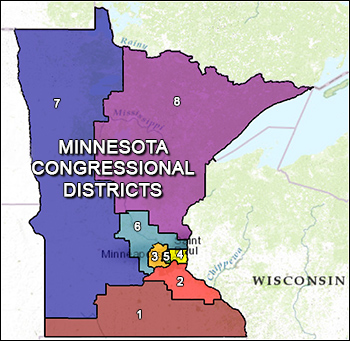By Jim Ellis
 Aug. 24, 2020 — The state of Minnesota has been the most loyal of Democratic states in the presidential election since 1972, but the latest survey research data suggests that the northern domain is returning to the competitive realm this year.
Aug. 24, 2020 — The state of Minnesota has been the most loyal of Democratic states in the presidential election since 1972, but the latest survey research data suggests that the northern domain is returning to the competitive realm this year.
Four years ago, President Trump fell just 1.5 percent short of winning Minnesota, thus providing a sign that the electorate was beginning a possible transformation. That was partially underscored in 2018 even when the party lost two suburban Minneapolis districts but gained two back in the rural north and south. The latter two congressional seats were the only ones Republicans converted from Democrats in the whole nation, except for a Pennsylvania seat that flipped to the GOP because of a court-imposed redistricting map that substantially changed the boundaries.
The 2020 Minnesota polls have seesawed. Mason-Dixon Polling and Research was the first to release a statewide poll this year and did so just before the George Floyd killing occurred in Minneapolis. The M-D survey was conducted over the May 18-20 period and yielded former vice president Joe Biden a five-point lead, 49-44 percent. The Morning Consult organization was also in the field during that same relative period, May 17-26, and found a similar spread between Biden and President Trump, with the former posting a seven-point edge.
Within this same period, the Floyd controversy began on May 25. During the next two months, a pair of Minnesota polls were conducted, and Biden’s lead soared into double digits. Gravis Marketing executed a single-day poll on June 19 and found Biden’s lead had grown to 16 percentage points. Fox News followed with their survey a month later, July 19-20, and found a similar 13-point Biden advantage.
The situation began to change when Morning Consult again tested the Minnesota electorate over the July 17-26 period and saw the race closing back into the three-point range. This survey was confirmed with the Trafalgar Group’s numbers derived from their July 23-25 poll that found a similar five-point margin developing between the two candidates.
The next two, however, from Public Policy Polling and David Binder Research, both conducted during the July 22-31 time frame, produced 10 and 18 point spreads in Biden’s favor. The Binder poll, however, utilized a sample size of only 200 respondents, far below what would be typically required for a reliable statewide poll for a domain housing eight congressional districts.
Moving into August, perhaps as the electorate adjusts back into a more typical voting mode after some time has passed since the tragic Floyd situation occurred, we see another definitive shift. During the Aug. 8-18 period, Emerson College detected the Biden advantage dropping to two points, and the Trafalgar Group, this week releasing the latest data (Aug. 15-18), finds President Trump rebounding all the way back into a flat tie, as both candidates received 47 percent support.
There are other perhaps more reliable signs that the state is shifting. In the Aug. 11 primary, Rep. Ilhan Omar (D-Minneapolis) was re-nominated in the district where the Floyd killing occurred. She faced an opponent who equaled her campaign spending – both expended over $4 million in the Democratic primary – and she prevailed with a 57-39 percent margin.
Two minor candidates received the remaining four percentage points, but 43 percent of the 160,938 Democratic primary voters (another 11,386 individuals voted in the Republican primary) didn’t support Rep. Omar. Adding the Republican vote meant that 46.4 percent of the aggregate 172,324 people who voted in the Aug. 11 primary supported a different candidate than freshman incumbent Omar. This, in a district where President Trump recorded only 18.5 percent support in 2016.
Another competitive sign occurred in the northwestern district, the 7th, which is the most pro-Trump district in the country that sends a Democrat to the House (veteran Rep. Collin Peterson). In this district primary, from a state where the Democratic turnout was twice the size of the Republican participation factor, 9,185 more Republicans voted than Democrats.
Additionally, in a Tarrance Group poll conducted before the Minnesota primary (Aug. 2-5) but released after the statewide vote, new Republican nominee Michelle Fischbach, the former lieutenant governor and state Senate president, actually led Rep. Peterson, a 30-year congressional veteran. The spread was 10 percentage points, 52-42 percent, in Fischbach’s favor, further suggesting a potential changing political tide.
If Minnesota were to flip in the presidential election, the entire national outcome could change. Therefore, this is a place well worth watching as the general election culminates.
